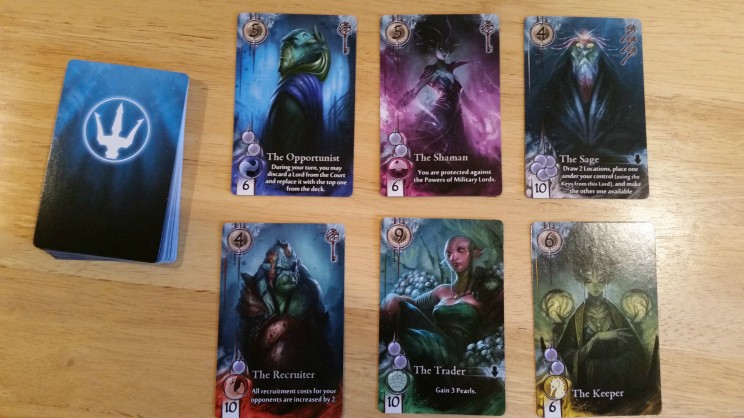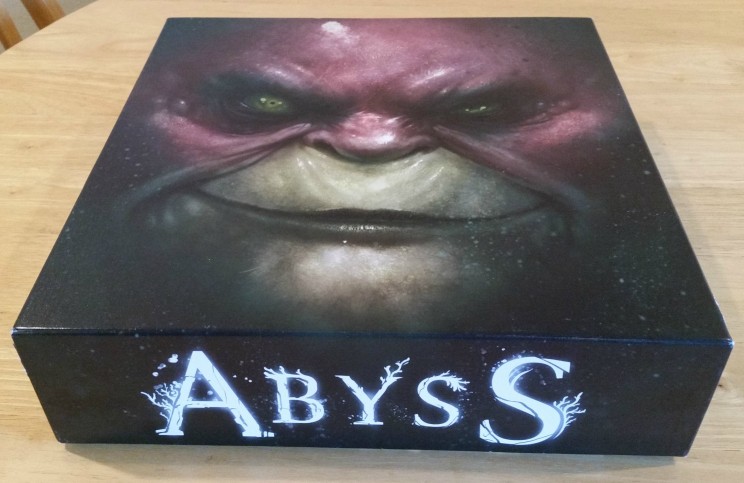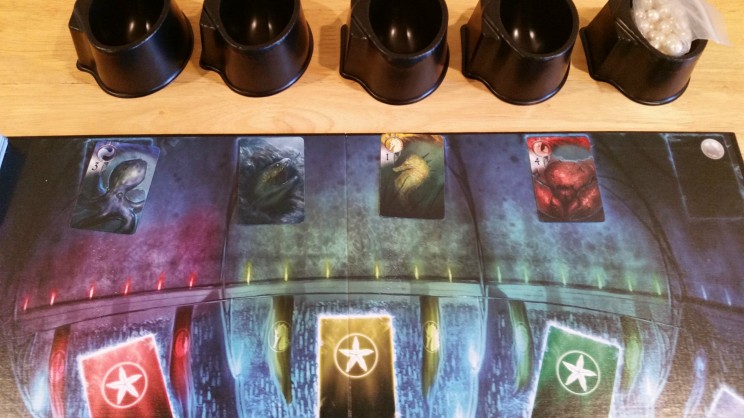Abyss
I work out of my home in North Liberty, Iowa, and as any telecommuter will tell you, lack of human interaction is the largest and most difficult aspect of the job. In an effort to curb the degradation of my basic social skills, I joined a local group of board game enthusiasts that meets once a week. My brother, who is also a board game enthusiast, asked me what games we were playing, so I started telling him about Abyss. Since then, several other people have asked me about the types of games we play, and Abyss is one of the best, most balanced board games I have played, so I tend to use it as an example.
The problem is that most of my friends haven’t ever heard of it.
So I thought it might be fun to do an impromptu “board game review” and share my thoughts on the game as well as some photos of the board and cards, because as far as I’m concerned, Abyss is one of the best looking games I have ever played. I’m not going to provide an opinion on whether to buy this game, because it should be pretty clear that I am not unbiased.
Overview:
Abyss is a 2-4 player Development game created by Bruno Cathala and Charles Chevallier, and published by Bombyx. The goal of the game is collect Ally cards of appropriate Guild and value in order to recruit Lord cards that grant points toward victory. A full game of Abyss can be played in 45 minutes if all players know the rules, but a teaching game can take as many as 3 hours, depending on how experienced the players are. The game includes:
- Game board
- Instructions
- Deck of Ally cards
- Deck of Lords
- Deck of Lands
- Pearls (currency)
- Monster track with token
- Monster tokens
- Keys
- Shells to hold the Pearls (one for bank, one for each player)
- Scoring pad
- Custom cut insert for the box for game component storage
Theme:
For centuries, creatures have ruled without peer in the depths of the oceans. Their kingdom, Abyss, is respected by all of their allies’ nations, happy to find protection there against fearsome undersea monsters.
Soon the throne will be vacant…
What if it is time for you to claim it?Time is short! There are only a few days to go before the crowning of the new monarch. To expand your influence and seem to be the only clear choice, you’ll have to explore, recruit, control…
–Abyss Website (www.abyss-the-game.com)
Abyss has an undersea theme with fantastic elements. The Allies and Lords have been divided into Guilds, each with their own specialization. Military Lords tend to negatively impact opposing players, Mage Lords tend to reduce or change costs when you recruit additional Lords, and so on. That attention to detail and internal consistency makes the game that much more enjoyable. Additionally, Lands tend to synergize with Lords and Allies, which can influence which Guilds the players recruit from.
Set-Up:
Once you’re familiar with the components of Abyss, set-up is quick, but it takes up a lot of space for a 4-player game. The board has clearly demarked locations for the decks of Allies and Lords, but no designated discard areas, so discard piles tend to be created adjacent to the board. Additionally, because the Land cards are so large (they’re designed to cover the powers of up to three Lords), and the mechanics surrounding how they are acquired, the area set aside for Lands can often expand well beyond the original area. I have seen groups put the Monster Tokens, Keys, and Lands in the box to clear space on small tables so that players have room. This appears to be a perfectly reasonable method for reducing the game’s footprint, since these components are the least used in the game.
Mechanics:
Gameplay is balanced and well considered. Players have to choose between increasing the cards in their hand or recruiting a Lord to increase their overall score and bring the game closer to completion. In the early game, players tend to default to Exploration in order to gather Ally cards into their hand and drive the economy. This mechanic is especially interesting to me, because it’s one of the few games I’ve played where players pay each other instead of the bank during the purchasing phase. In the beginning, Pearls are only useful for purchasing Ally cards from other players Exploring, but once you’ve accumulated more than 3 or 4 Pearls, your options open up and you can use them to supplement the recruiting cost of Lords in order to keep higher value Affiliates.
In the midgame, the Council section of the board begins to fill with the Allies that didn’t make the cut during previous Exploration rounds. Because players can take entire stacks of Allies from the Council, this becomes the “go-to” action for players looking to shore up their hand just before a Lord purchase.
The Lords each have their own unique powers, which are often inversely proportional to their influence score. Powerful Lords that impact the overall flow of the game often have low point values, while those with no special powers tend to have high influence. Furthermore, Lords with powers also usually have Keys associated with them, and because the game rules require players to select a Land after 3 Keys have been accumulated (which cancels the powers of the Lords associated with the Keys on them), the mid to late game requires the players to constantly weigh the short-term benefits of their Lords’ powers versus the end-game points boost of the Land. Because each of the Guilds are themed towards different suites of powers, players must also consider whether to recruit the Lords that are beneficial to their own strategy or those that negatively impact their opponents.

While there are only five Guilds in the game, the sixth type of Lord is an Elder, who is unaffiliated with any of the others and requires at least one Ally of each color to recruit. There are three Elders in the game and each immediately grants the recruiting player a Land.
The end-game condition is triggered when one player recruits their seventh Lord, but other players each get an additional turn to see if they can shore up any final gaps. Because each of the 35 Lords have unique powers, some of the Lords synergize off of each other very well. More often than not, on the final turn of the game, players are searching for any way to gather just one more Lord, Affiliate, and, where possible, Land to secure their victory. But sometimes, the perfect blend of Lords are available and it’s possible to recruit more than one Lord, causing a major swing in points.

Example Lands. Each Land is unique and affects scoring differently. When Lands come into play, they immediately cover the Lords that were used to capture them, preventing that Lord’s power from being used for the remainder of the game. This balances the Lord’s with immense power by forcing players to choose between that power and the additional influence points.
Scoring is simple, but time-consuming, because the Lands tend to alter the way that your Lords or Affiliates are scored, or are themselves dependent on the number of Lords or Allies from a specific Guild. The scoring pad is incredibly useful and breaks down all the different ways that players can earn points: Lands, Lords, Affiliates, and Monster Tokens.
Value:
Abyss is beautiful and all the cards and components are of extremely high quality. This is understandable, because the game retails for $60 plus tax. I especially enjoy the replay value, because with the number of unique Lords and Lands, dozens of games can go by without seeing all possible combinations, which means that strategies will change each game. The game itself ships with one of five unique covers. I received my copy as a gift that was purchased on Amazon, so the box art I received was random. I have been told that you can order from your local game store or from the publisher to select the cover you want.
In summary, Abyss is a complicated and innovative board game with beautiful art and high production value. It takes a little while to learn, mostly because each Lord and Land is unique and a lot of time is lost to explaining the new mechanics each time one of these cards are played, but once all the folks are well versed in the rules, a full game can be played in under an hour. Set-up is easy, if a little sprawling, but Abyss has fewer components than some other games, like Lords of Waterdeep or Puerto Rico. In my opinion, Abyss is a great gateway game between games like Settlers of Catan to more idiosyncratic games like Dominion.



